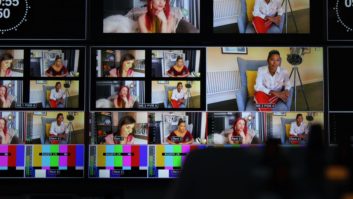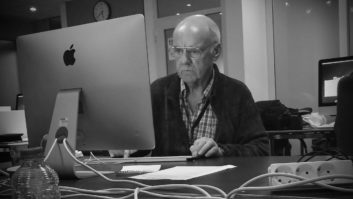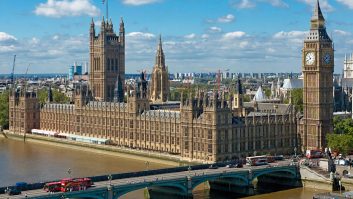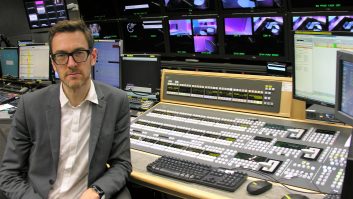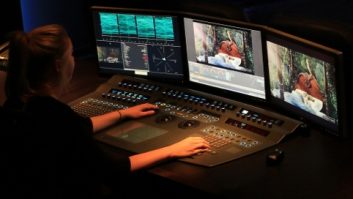Philip Stevens walks along one of the most famous streets in British TV and reviews the history of the long-running, award-winning soap
It’s approaching 1900 hours on 9 December 1960. In the production gallery of Studio 2 of Granada Television’s Manchester headquarters, the PA to director Derek Bennett is counting down to the start of a new 13-part drama series featuring the residents of a fictitious street in the city’s suburbs. Little did anyone know that when the Granada logo appeared on screen and the now familiar strains of the theme music were heard, that Coronation Street would still be running more than 50 years and 8000 episodes later. At its peak, well over 25 million viewers tuned in to watch the happenings of Weatherfield (as the fictitious suburb is called).
“Coronation Street has seen many changes in its fifty-three year history. Over five decades it’s grown from two to five episodes per week and seen countless technical and production advances, including the introduction of colour pictures in 1969, wide screen in 2002 and high definition in 2010,” states the current executive producer, Kieran Roberts.
However, the most recent of the changes has involved the production moving to a completely new 7.7acre purpose built studio block and exterior set located close to MediaCity UK – Salford’s production centre just outside of Manchester. Centrepiece is the construction of the actual street and surrounding buildings. To provide a thoroughly authentic feel, nearly half of the facing bricks used to construct the buildings were reclaimed from a derelict Salford street. In addition, a total of 54,000 cobble stones have been laid on the new street – with these being reclaimed from Salford and the canalside in nearby Eccles.
The early days
So, what is the story behind the production of Corrie (as the programme is now affectionately known)?
Marconi Mk III cameras were used on that first episode in 1960. Broadcasting in 405 lines and with lens turrets (it would be some years before zoom lenses became the norm), the camera moves had to be carefully choreographed by the director for the live show involving a large number of different sets in a relatively small studio.
Initially, the programme was shown twice a week. The Friday episode would be transmitted live, immediately followed by a recording of the upcoming Wednesday’s show. Although recorded on 2in Ampex tape, Granada set up a film camera in front of the VT preview monitor to also capture a telerecording of the early programmes.
In those early days, even the ‘exteriors’ were shot in the studio – with the cobblestones being painted on the studio floor. However, the show’s producers decided that external shots were needed for a 1967 storyline that involved a tram crash close to the Street. That first external set was simply the previous wooden studio build which had been weather-proofed and then erected against scaffolding by the yard arches.
“The first outdoor set was on the site of an abandoned railway goods yard,” recalls the show’s creator, Tony Warren. “It already had cobbles, but they slanted the wrong way. I remember it as a dank hole. Between shots the cast could take shelter from the wind and the rain in an old Nissen hut.”
By the late 1960s, when production had moved from black and white to colour, the wooden set had become so severely dilapidated by the Manchester weather that it needed to be replaced with a small brick built construction.
The first colour episode was produced in early November 1969 using EMI 2001 four-tube colour cameras although the title credits, end credits and location inserts were still in black and white. The next three episodes were made in the same way, but all four were networked in black and white, until ITV started colour transmissions later that month.
As the programme’s success continued to grow and more demands were placed on storylines and production deadlines, it was decided to rebuild the whole set in a new location near to Granada’s Quay Street centre.
“Denis [Parkin – the show’s designer] finally got to build his real street in the eighties,” states Warren. “That was when Coronation Street had its own purpose built unit. That street is the outdoor set we have used until now.”
The new Street
The move to the latest set has been a couple of years in the planning. “When we broke ground at Trafford Wharf Road in September 2011, ITV had already been planning our move to MediaCityUK for a significant period of time,” declares Jon Huddleston, ITV’s Manchester move project director. “But the most challenging piece of the jigsaw has been to rebuild Coronation Street – terraces, pavements, cobbles and all. To build something new, whilst recreating brick-by-brick, cobble-by cobble, puddle-by-puddle, the fine detail of Weatherfield has been the most incredible experience.”
Alongside the actual ‘street, the Corrie site consists of four studios, all dedicated to the programme. “We have a total floor space of around 33,50sqft– 3105sqm,” states Stan Robinson, technical manager, Coronation Street.
“There are two galleries, but any studio can be connected to either gallery depending on the production requirements of the day.”
Three Ikegami HDK 79 III cameras are employed in each studio, although a fourth can be accommodated, if necessary. “Our studio cameras are equipped with Canon XJ22 box lenses, while on location the choice of lens is HJ17. We decided to use the same cameras for both studio and location shoots to ensure consistency.”
Each gallery is equipped with a FOR-A HSV 300 vision switcher. “It is a small mixer – but we do not need anything more elaborate as all the cuts are eventually made in post production,” explains Robinson. “For audio mixing, we have opted for Studer Vista 1. Previously, we used analogue mixers, but the move allowed us to go for a digital unit.”
Unique network
That digital format has allowed Robinson to introduce a unique fibre transportation system for the signals around the site. Based on an Optocore network structure, Robinson designed portable stageboxes that allow signals from the studios (or anywhere else on the site, for that matter) to be routed to either gallery. “There are no technical wall boxes. Each gallery has its own stagebox, and we simply wheel it to where we are shooting and plug in to our SMPTE 311M camera cable network. There are 100 SMPTE sockets distributed around the site that can be patched to Camera Base Stations or to the Optocore Router. Once connected the signals are automatically routed delivering signals, such as microphones, foldback, picture monitoring, video router control and talkback to the Studio Floor and Galleries. In effect, the whole site becomes our studio floor.”
The stagebox also incorporates the microphone amplifiers. Once a microphone is plugged into appropriate input in the box, that source immediately appears on the relevant fader in the sound control room.
“Another innovation is our ETC Paradigm lighting control system which allows strip lights around the studio to be controlled by the gallery to show the status of that studio. Our studios are large, and it could be that a scene is being recorded in one area, while a set is being built in another. With several sets in each studio, the view across the floor is severely restricted, but this lighting system ensures all areas can immediately see if the studio is in rehearsal or ‘live’ mode.”
Lighting the studio and location sets is a mixture of LED and tungsten lamps. “We are utilising an app which allows the lighting directors to make adjustments through their iPads, if necessary. That means they don’t have to return to the gallery each time a change is required.”
Careful planning
With five episodes a week to be transmitted, each involving several interior sets, plus shooting on the ‘Street’ and other locations, the production schedule is extremely complex. For any given week, 15 episodes are in production.
Each week’s shows are considered as a ‘block’ to which a director is assigned. He or she will receive the script prior to shooting of the assigned programmes. The technical details and set allocation will be worked out and then a 12 day cycle of shooting the five programmes will begin.
“The three cameras in the studio will be recorded separately, but there is also a cut version from the vision mixer. An EDL (Edit Decision List) will also be created. When we are shooting exteriors, two cameras are generally used,” reveals Robinson.
Studio recordings are sent straight to an Avid four channel Airspeed 5000. The material is transferred to an Avid Isis 5000. Exteriors are captured on P2 cards which are then reused once transfers and back ups to the Avid system have been made.
“We have back up units, and within a few seconds of ingest we have three copies of the recorded material. Even by lunchtime on the first day of shooting, assistant editors will start compiling clips ready for editing. By the end of the first day, editing will have started. The director may visit the edit suite from time to time, but there is a day allocated at the end of the ‘block’ for him or her to review the cut versions.”
The post production area includes colour grading rooms, a voiceover booth and dubbing suites.
The move was completed earlier this year – with the first episode from the new location due to be shown in mid-March. “It has been a hectic time,” admits Robinson, “but things have gone well and we can look forward to a long residency in our ‘new’ street.”
www.itv.com/coronationstreet
www.avid.com
www.canon.co.uk
www.etcconnect.com
www.for-a.com
www.ikegami.com
www.optocore.com
www.studer.ch
